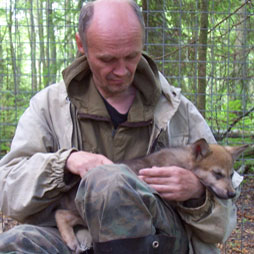Polymorphismus und unterschiedliche ökologische Typen eines städtischen Streunerhund-Bestandes
- Research of stray dogs populations in Moscow.
Stray dog population demonstrate very high level of density. The extrapolation counting 2006 showed the mean number 26159 (reliable statistical interval 22344 – 30626) and density from 2-70 individuals per 1 km2. How it is possible? Behavioral and ecological polymorphism in stray dogs populations is found in the most part of investigated parameters. Among these basic parameters determining stray dogs life strategies are: home site size, expression of territorial behavior, feeding strategies, relation to humans, development and differentiation of social behavior towards conspecifics.
- Variety of home site size differed for different stray dog groups greatly: from 1-2 hectares to 5-15 square km. So the range of this parameter can reach two orders. The sites differ greatly not only in size but in the development of their inner structure. Big home sites always overlap of other social groups and include several places of common use. So inner structure and complexity of a big site always differ from those of a small site.
- Territorial behavior. Several individuals and social groups do not show territorial behavior neither to other dogs nor to humans. Rather often phenomenon is partial territoriality when a social group or an individual demonstrates territorial behavior not to all stray dogs appearing in its territory. There are stray dogs in city populations that demonstrate pronounced territoriality towards all intruders.
- Following stray dogs feeding strategies can be described: freeloaders, beggars, collectors and dogs of prey. Freeloaders are dogs receiving ration from personally well known humans and not demonstrating special behavior aimed at begging food. To put it more exactly, probability of getting food does not depend of their behavior. Beggars are dogs demonstrating pronounced behavioral complex of asking for food. Their behavior is directed not to personally known humans but to humans in general. Collectors are dogs that find and gather most of their ration (in the form of human waste) themselves. Hunt can not be main foraging in a city. As a rule objects of hunt become different rodent species and more rarely cats. A stray dog can use 2-3 feeding strategies but in such a case one of them is the main one delivering the main part of the ration.
- The stage of savagery. Relation of stray dogs to humans also have several forms named stages of becoming feral (Poyarkov, 1989). Dogs most socialized to humans can be called conventionally neglected. They know several people with whom they have established individual personal social bonds. Those dogs are obedient to these people.
- The next dog type can have humans acquainted to them but they are not ruled by those. There are in the city dogs not socialized to humans – feral dogs. They treat humans as an element of their surroundings behavior of which must be taken into consideration (first of all to escape negative influences from it) but not as a social partner.
- Ecological type of stray dogs. Wide polymorphism noticed in different parameters has some restrictions, so as several parameters are connected and go together. For example a feral dog in the city always uses gathering feeding strategy as the main one, has a wide home site and is moderately territorial.
- In contrast to it conventionally neglected dog uses freeloading feeding strategy, has a small home site and as a rule is strictly territorial. This connections of different grades of different parameters makes it possible to distinguish several ecological (eco-ethological) types of stray dogs.
- It is of principle importance that those ecological types exist in one city population of stray dogs. To our opinion existence of different ecological types significantly widens ecological potential of developing high population density for makes it possible to use wide range of feeding and territorial resources, and (which is not less significant) to a great extent lowers tension in the ethological population structure by combining groups that use different behavioral strategies.
- It is the coexistence of social groups with different behavioral strategies in one site lessens the competition between them and creates possibilities for very dense „package“ of city stray dogs populations.
- Not lesser polymorphism can be observed in stray dogs morphotypes. In one population you can meet different size classes, colors, coat types and different constitutional types of stray dogs.

